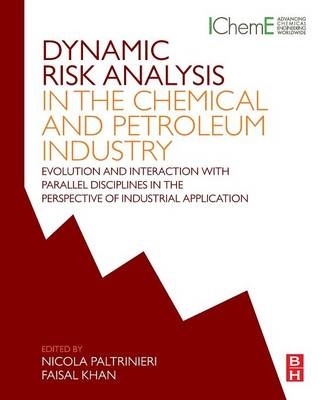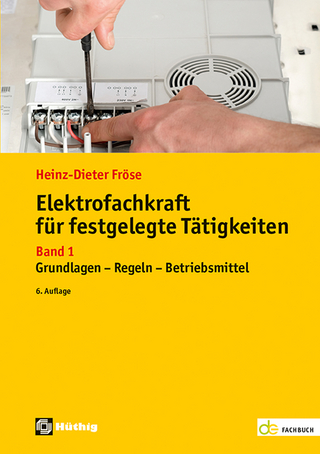
Dynamic Risk Analysis in the Chemical and Petroleum Industry
Butterworth-Heinemann Inc (Verlag)
978-0-12-803765-2 (ISBN)
What are the most relevant developments of risk analysis?
How can these studies help industry in the prevention of major accidents?
Paltrinieri and Khan provide support for professionals who plan to improve risk analysis by introducing innovative techniques and exploiting the potential of data share and process technologies. This concrete reference within an ever-growing variety of innovations will be most helpful to process safety managers, HSE managers, safety engineers and safety engineering students.
This book is divided into four parts. The Introduction provides an overview of the state-of-the-art risk analysis methods and the most up-to-date popular definitions of accident scenarios. The second section on Dynamic Risk Analysis shows the dynamic evolution of risk analysis and covers Hazard Identification, Frequency Analysis, Consequence Analysis and Establishing the Risk Picture. The third section on Interaction with Parallel Disciplines illustrates the interaction between risk analysis and other disciplines from parallel fields, such as the nuclear, the economic and the financial sectors. The final section on Dynamic Risk Management addresses risk management, which may dynamically learn from itself and improve in a spiral process leading to a resilient system.
Nicola Paltrinieri is an associate professor at the department of Production and Quality Engineering of Norwegian University of Science and Technology (NTNU). He received his Ph.D. in Safety Engineering from the University of Bologna (Italy). He has worked in internationally renowned research teams at the Netherlands Organization for Applied Scientific Research (TNO), the Health and Safety Laboratory (HSL) in the United Kingdom, the Memorial University of Newfoundland in Canada and the Foundation for Scientific and Industrial Research (SINTEF) in Norway. He was awarded with the Onsager fellowship for established reputation for high-quality research. He is involved in a number of projects on advanced techniques of risk analysis in collaboration with world leading oil and gas companies. He is interested in the study and improvement of risk management in the broadest sense, from economic to organizational implications.. Faisal Khan is a Chemical Engineering Professor and Director of the Mary Kay O’Connor Process Safety Center and the Ocean Energy Safety Institute, Texas A &M University. He is the founder of the Centre for Risk Integrity and Safety Engineering (C-RISE), a Fellow of the Canadian Academy of Engineering, the Engineering Institute of Canada, and the Canadian Society of Chemical Engineering. His areas of research interest include offshore safety and risk engineering, inherent safety, risk management, and risk-based integrity assessment and management. Dr. Khan is actively involved with multinational oil and gas industries on the issue of safety and asset integrity. He also served as the Safety and Risk Advisor to the Government of Newfoundland, Canada. He continues to serve as a subject matter expert to many organizations including Lloyd’s Register EMEA, SBM Modco, Intecsea, Technip, and Qatar-gas. He served as a Visiting Professor of Offshore and Marine Engineering at Australian Maritime College (AMC), University of Tasmania, Australia where he led the development of offshore safety and risk engineering group and the initiative of global engagements with many international institutions. He is the recipient of President Outstanding Research Award of 2012-13 at Memorial University, President Outstanding Research Supervision Award of 2013-14 at Memorial University, CSChE National Award on Process Safety Management of 2014, P, and Society of Petroleum Engineer award for his contribution to Health, Safety and Risk Engineering. He has authored over 500 research articles in peer-reviewed journals and conferences on safety, risk, and reliability engineering. He has authored five books on the subject area. He is the Editor of the Journal of Process Safety and Environmental Protection, Safety in Extreme Environment, and ASME Part A (Risk and Uncertainty Analysis). He regularly offers training program/workshop on safety and risk engineering in different places including St John’s, Chennai, Dubai, Beijing, Aberdeen, Cape Town, Doha and Kuala Lumpur.
Part I: Introduction 1. A short overview of risk analysis background and recent developments 2. New definitions of old issues and need for continuous improvement
Part II: Dynamic Risk Analysis Sub-section 1: Hazard Identification 3. Advanced techniques for dynamic hazard identification 4. Dynamic hazard identification: tutorial and examples
Sub-section 2: Frequency Analysis 4. Reactive approaches of probability update based on Bayesian inference 5. Proactive approaches of dynamic risk assessment based on indicators 6. Coupling of reactive and proactive approaches: tutorials and examples 7. Comparison and complementarity between reactive and proactive approaches
Sub-section 3: Consequence Analysis 8. Dynamic consequence analysis through Computational Fluid Dynamics modelling 9. Computational Fluid Dynamics modelling: tutorial and examples 10. Assessing the severity of thermal hazards 11. Thermal hazard assessment: tutorial and examples
Sub-section 4: Establishing the Risk Picture 12. Risk metrics and dynamic risk visualization
Part III: Interaction with Parallel Disciplines Sub-section 1: Humans 13. Human Reliability Analysis: from the nuclear to the petroleum sector 14. HRA in the petroleum industry: tutorial and examples
Sub-section 2: Costs and Benefits 15. Cost-Benefit Analysis of safety measures 16. Cost-Benefit Analysis for low-probability high-impact risks: tutorial and examples
Sub-section 3: Reputation 17. Reputational damage following major accidents 18. Estimation of major accident reputational damage: tutorial and examples
Part IV: Dynamic Risk Management 19. Dynamic Risk Management in the perspective of a resilient system
| Erscheinungsdatum | 26.08.2016 |
|---|---|
| Verlagsort | Woburn |
| Sprache | englisch |
| Maße | 191 x 235 mm |
| Gewicht | 610 g |
| Themenwelt | Technik ► Elektrotechnik / Energietechnik |
| Technik ► Umwelttechnik / Biotechnologie | |
| Wirtschaft | |
| ISBN-10 | 0-12-803765-2 / 0128037652 |
| ISBN-13 | 978-0-12-803765-2 / 9780128037652 |
| Zustand | Neuware |
| Haben Sie eine Frage zum Produkt? |
aus dem Bereich


